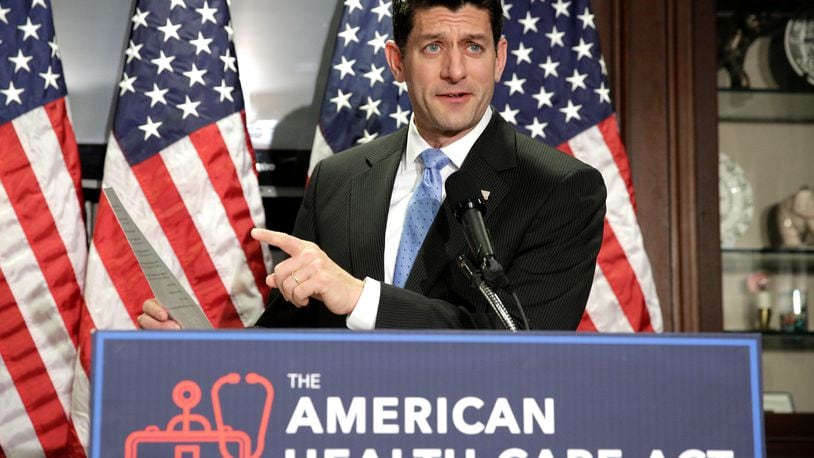RELATED: Will Obamacare repeal leave Ohioans in the lurch
Locally, health care jobs have grown to account for 19 percent of all private-sector employment in Montgomery County, which is one of only 10 Ohio counties where at least one in six private sector employees works in health care, according to the Policy Matters, a left-leaning think-tank with offices in Columbus and Cleveland.
Statewide, more than one out of seven Ohioans, or 676,948 residents, worked in the private health care sector in 2015, accounting for 14.9 percent of total employment in the state — up from about 11.1 percent in 2000.
But proposed cuts in the AHCA could eliminate more than 81,000 jobs by 2022, based on projections released in March by the Economic Policy Institute and referenced in the Policy Matters’ report.
RELATED: ACA cuts number of uninsured Ohioans nearly in half
“Clearly the health care sector is increasingly important to Ohio’s still struggling economy,” said Wendy Patton, senior project manager at Policy Matters. “This is the wrong time to destabilize it further.”
The biggest impact of the AHCA would be in the way it would roll back Medicaid expansion in 31 states, including Ohio, where more than 70,000 low-income residents are now covered by Medicaid under new eligibility rules that allow most able-bodied, childless adults with incomes under 138 percent of federal poverty level to qualify for coverage.
The AHCA would strip $800 billion from the state and federal health insurance program for the poor over the next decade, with Ohio losing an estimated $23 billion in Medicaid funding, according to the report.
RELATED: GOP health bill threatens Ohio Medicaid
But its far to too soon to tell what the impact might be, according to Niraj Antani, R-Miami Twp.,who said opponents of the AHCA may be sounding the alarm prematurely.
“Obamacare (ACA) has to be repealed and replaced,” Antani said. “I don’t think we can speak right now as to what the impact might be. I’m sure the Senate is going to have revisions (to the AHCA), and then there will be further revisions in a conference committee. We have to let the legislative process in (Washington), D.C. play out, and at the state level, we’ll comply with whatever comes out of D.C.”
Still, the local economy would likely suffer an out-sized impact if the proposed proposed cuts in the House version of the health care bill remain in tact. That’s because a disproportionate number of residents gained coverage through Medicaid expansion, which helped local hospitals cut their costs for providing care to the uninsured by millions of dollars.
RELATED: Hospitals see major reduction in charity care costs
“Premier Health stands to lose $861.1 million in Medicaid cuts through 2026, and see a $182 million increase in costs for treating people who are uninsured,” said Mike Uhl, president of Premier’s Atrium Medical Center in Middletown. “Combined, these potential cuts to Medicaid funding and increases in uncompensated care would undermine the health care safety net that our hospitals have become for our communities’ most vulnerable citizens. They also would force us to cut services and eliminate jobs.”
Nationally, hospitals saw a 21 percent decrease in the cost of so-called uncompensated care between the 2014 adoption of the ACA — former President Barack Obama’s signature health care law — and 2015, according to Policy Matters, and $5 billion of the $7.4 billion saved on uncompensated care happened in Medicaid expansion states like Ohio.
Here is a summary of major provisions of the American Health Care Act passed by the U.S. House of Representatives:
■ To help people buy insurance, if they do not have coverage at work or under a government program like Medicare or Medicaid, or through the Department of Veterans Affairs, the bill would offer $2,000 to $4,000 a year in tax credits, depending mainly on age. A family could receive up to $14,000 a year in credits. The credits would be reduced for individuals making over $75,000 a year and families making over $150,000.
■ Under current rules, insurers cannot charge older adults more than three times what they charge young adults for the same coverage. The House bill would allow them to charge five times as much. The Congressional Budget Office said this change would reduce premiums for young adults and increase premiums for older Americans.
■ The bill would end Medicaid as an open-ended entitlement to health care and would put the program on a budget. States would receive an allotment of federal money for each beneficiary, or, as an alternative, they could take the money in a lump sum as a block grant, with fewer federal requirements. Medicaid cuts would total $880 billion over 10 years.
■ The bill encourages people to maintain “continuous coverage” by requiring insurers to impose a 30 percent surcharge on premiums for those who experience a gap in coverage.
■ Under the bill, states could opt out of certain provisions of the Affordable Care Act, including one that requires insurers to provide a minimum set of health benefits, such as maternity care and emergency services, and another that prohibits them from charging higher premiums based on a person’s health status. Insurers would not be allowed to charge higher premiums to sick people unless a state had an alternative mechanism, like a high-risk pool or a reinsurance program, to help provide coverage for people with serious illnesses.
■ The bill would provide states with $138 billion over 10 years that could be used for various purposes like subsidizing premiums, providing coverage to people with pre-existing conditions and paying for mental health care and the treatment of drug addiction.
Source: The Associated Press
About the Author
